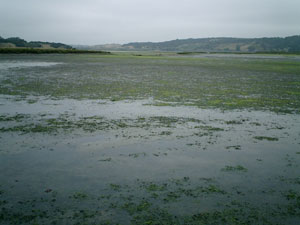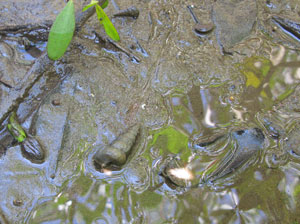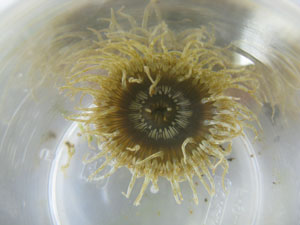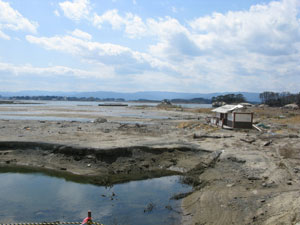Parasites alter host phenotypes
 Parasites may greatly impact host ecology. We found marine snails infected by trematode parasites move to lower intertidal, resume growth after maturation, and consume different resources. The shift in host body size and habitat would facilitate the transmission of parasites to their next hosts and thus would be beneficial to parasites. It looks like parasites manipulate host ecology for their benefits. We are currently interested in the mechanisms of these manipulations.
Parasites may greatly impact host ecology. We found marine snails infected by trematode parasites move to lower intertidal, resume growth after maturation, and consume different resources. The shift in host body size and habitat would facilitate the transmission of parasites to their next hosts and thus would be beneficial to parasites. It looks like parasites manipulate host ecology for their benefits. We are currently interested in the mechanisms of these manipulations.
Marine Invasive Species
 There are increasing risks for the invasion of exotic species due to the improvement of transportation facilities. Ship transportation provides a lot of benthic and planktonic invasive species in the marine ecosystem. We investigated the invasion pathway of Asian mud snails and their parasites which introduced to the west coast of the US. Our results showed that the hosts and parasites are not always move together. Parasites can disperse a long distance by bird transportation and thereby parasites can invade to new region without human mediation after the introduction of their hosts.
There are increasing risks for the invasion of exotic species due to the improvement of transportation facilities. Ship transportation provides a lot of benthic and planktonic invasive species in the marine ecosystem. We investigated the invasion pathway of Asian mud snails and their parasites which introduced to the west coast of the US. Our results showed that the hosts and parasites are not always move together. Parasites can disperse a long distance by bird transportation and thereby parasites can invade to new region without human mediation after the introduction of their hosts.
Diversification of hosts and parasites
 The Central American Isthmus provides an outstanding natural laboratory for the evolution of marine lives. The completion of the Isthmus about 3 million years ago separated the Pacific and Atlantic, creating a barrier to dispersal for marine species. Many marine species were separated by this barrier, promoting genetic divergence and allopatric speciation. We study the evolution of mangrove snails and their parasites in Central America to evaluate whether host speciation facilitates parasite diversification.
The Central American Isthmus provides an outstanding natural laboratory for the evolution of marine lives. The completion of the Isthmus about 3 million years ago separated the Pacific and Atlantic, creating a barrier to dispersal for marine species. Many marine species were separated by this barrier, promoting genetic divergence and allopatric speciation. We study the evolution of mangrove snails and their parasites in Central America to evaluate whether host speciation facilitates parasite diversification.
Social Organization in flatworms
 A recent study by Hechinger et al. (2011) found the social organization of a trematode parasite which includes reproductive and soldier castes. We found that three trematode species in Japan also exhibited a similar caste formation. We now study how they distinguish enemy and colony member and also investigate evolutionary mechanisms which facilitate the formation of the social system.
A recent study by Hechinger et al. (2011) found the social organization of a trematode parasite which includes reproductive and soldier castes. We found that three trematode species in Japan also exhibited a similar caste formation. We now study how they distinguish enemy and colony member and also investigate evolutionary mechanisms which facilitate the formation of the social system.
Symbiosis of zooxanthellae in sea anemones
 As like corals, several sea anemones have symbiotic algae in their tissue, which provide the nutrients to their anemone hosts. There are several species of symbiotic algae in sea anemones, which exhibit distinct responses to environmental stresses such as temperature and light condition. We study the ecology of these algae in association with environmental stresses in the intertidal shore.
As like corals, several sea anemones have symbiotic algae in their tissue, which provide the nutrients to their anemone hosts. There are several species of symbiotic algae in sea anemones, which exhibit distinct responses to environmental stresses such as temperature and light condition. We study the ecology of these algae in association with environmental stresses in the intertidal shore.
Disturbance of benthic community by tsunami waves
 On 11 March 2011, an undersea earthquake off the coast of the Tohoku district created tsunami waves that hit the Pacific coastline of northeastern Japan. This tsunami caused a significant natural disturbance on benthic communities in this region. We study the ecological and genetic aspects of intertidal snails to estimate the damages caused by the tsunami waves.
On 11 March 2011, an undersea earthquake off the coast of the Tohoku district created tsunami waves that hit the Pacific coastline of northeastern Japan. This tsunami caused a significant natural disturbance on benthic communities in this region. We study the ecological and genetic aspects of intertidal snails to estimate the damages caused by the tsunami waves.
Other Researches
We also study the evolutionary history of freshwater snails, seasonal variation of trematode prevalence in marine snails, etc.

